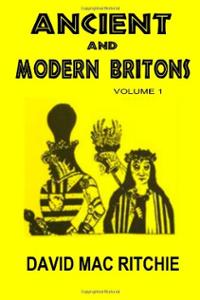Ancient & Modern Britons. Vol 1
 Author: David Mac Ritchie
Author: David Mac Ritchie
Paperback: 408 pages
First Published: 1996
Publisher: African Tree Press, 2011
Language: English
ISBN-10: 1592322255
ISBN-13: 978-1592322251
Details: Book I and II are to be found in Volume I. Book III is to be found in Ancient and Modern Britons, Vol. 2.
This book focuses on the early/original inhabitants/historical conquerors of the British Isles who weren’t white. There have been various peoples who had been known by even more names. And confused by name with each other. There are the original black inhabitants, some Egypt colonizers, conquering “Danes” and other Black (!) Scandinavians and Huns/”Scythians”. The author focuses on the culture of the “Gypsies”, with all the possible meanings of this term.
He meticulously explains names meaning Black and geographic areas referencing their bygone Black inhabitants. There are also reflections on Black history usually dropped or disguised in school and elsewhere in popular culture. Also traces in contemporary culture are examined. Of 1884 that is, for that’s the original publishing date.
Usually, that old books are hopelessly out of date. Yet, most of this book isn’t, for it is about historical research of names etc., which doesn’t really change that much, no matter, when you do that. In fact, David MacRitchie is closer to the times he describes than we are, which in some aspects is an advantage. There are sources available which have been destroyed, people(s) and culture still existing (even part-time troglodytes!), having vanished in the meantime. Linguistics are still better traceable. And most of all: He seems to be some sort of pioneer. Mostly, he is doing original research and reflecting primary sources, not merely copying other historians’ findings. In other words, he is still unimpressed with any meme (memory) pool notion of whitening European/British history, which has happened since, while the availability of this book had been downpressed.
What wasn’t known, for example, in the 19th century is the Indian origin of the “Roma and Sinti” (“Gypsies”). Which has been found out via linguistics later. But what has happened ever since is that ALL people(s), who are “known” today as “Gypsies” or by any supposedly politically correct name, are believed to have come from India. Which isn’t the case. Some non-white European peoples may have (visually and/or for real) vanished altogether by now. Of course, Europe had to have been populated by “Black”/non-white people, before one mutation for “White” occurred, which then expanded, putting ever more pressure on the original inhabitants (i.e. in part the same people, only changed in skin color). Genetics confirm that several of the first European inhabitation waves weren’t white skinned. As islands, the ancient “UK” and Ireland, of course, harbored those non-Whites much longer than most parts of “continental Europe”. But there are also Black references in this book of other countries, such as Spain, Denmark and Germany. All of the latter (Black) re-influencing the British Isles in the last two millennia.
Most interesting is the history, not that awfully long ago, of INNER-European slavery, i.e. of the enslavement of non-Whites, after the belligerent downfall of the Black kingdoms/earldoms, persecution, expatriations and genocides of Blacks, even referencing the witchhunt as originally designed to annihilate Black druidesses. (It wasn’t called “black magic” to describe the magic, but the skin color of the people “engaging” in it.)
David MacRitchie’s literary style may be a bit dry and appearing at times a bit repetitive, yet the reader will stay awake, not only for the naked bodies and cruelties described all the time, but mostly for the fascinating revelations, such as the context of the origin of the word “blackmail”, the various children’s games of who’s afraid of the Black man, and even the Tories. But also of the professional descendents of Blacks, such as clowns and tattooed sailors. The 19th century language seems funny at times, with different meanings for the words “Bohemian”, “gay colours” (which is the most harmless example in that direction, I may hint), and names mentioned, which have become much more famous in the meanwhile (“Potter”, which fascinatingly makes sense in the Harry version). Occasionally, he addresses the reader of the 21st century and predictions for the 20th century have become true.
The subtraction of a star is the result of a lacking preface, updating this work, i.e. dusting it thoroughly. Also for the racist-classist-culturalist attitudes of the book. Which astonishingly isn’t as bad as the times were in general. Sure, there’s much talk about savagery, ugliness and low end of humanity, etc., yet in a context completely in reverse at times, even accusing White culture a lot.
In short: This book is an essential classic in overstanding that white European culture has emerged in various ways along black culture. Even though further (modern) knowledge lacking in this book helps a lot in overstanding this even better.

